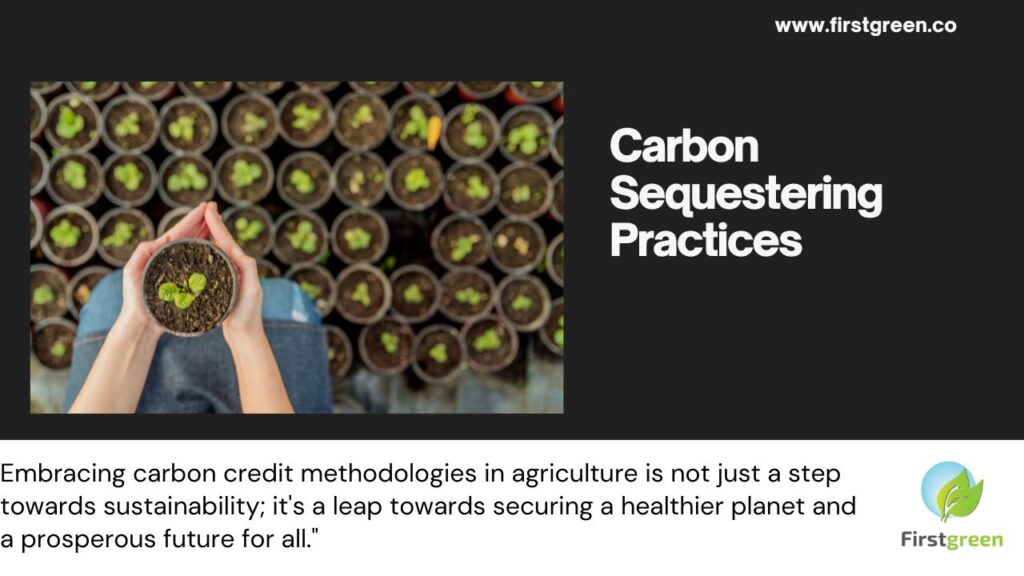Carbon Sequestering Practices: Boosting Agriculture and Environmental Sustainability

The agriculture sector, pivotal in global food production, also plays a significant role in emitting greenhouse gases. However, innovative carbon credit methodologies offer opportunities to transform this sector into a vital part of the climate solution. By adopting carbon sequestering practices, farmers can generate carbon credits, creating financial incentives while contributing to environmental sustainability. This blog explores five effective carbon credit methodologies in agriculture, with examples and a summary table of registered projects.
1. Afforestation and Reforestation (A/R)
This methodology involves planting trees on previously non-forested land or restoring forests where they once existed. Trees act as carbon sinks, absorbing CO2 from the atmosphere. This method enhances biodiversity and soil stability while sequestering carbon. Credits are earned based on the amount of carbon dioxide sequestered.
Example: The Scolel’te project in Mexico encourages smallholder farmers to plant native trees, combining reforestation with sustainable agricultural practices.
2. Improved Agricultural Land Management (ALM)
ALM practices increase soil carbon storage through no-till farming, crop rotation, and cover cropping. These practices not only capture more carbon in the soil but also improve agricultural output by enhancing soil health.
Example: The Soil Carbon Initiative in the United States incentivizes farmers to adopt practices that boost soil organic carbon levels, thereby earning carbon credits.
3. Methane Capture and Combustion
Methane, a potent greenhouse gas, is a byproduct of livestock farming and manure management. Capturing this methane to generate energy not only prevents its release into the atmosphere but also transforms waste into a clean energy source, generating carbon credits based on the methane controlled.
Example: Dairy farms in California utilize anaerobic digesters to capture methane from manure, using it to generate electricity while earning carbon credits.
4. Agroforestry
Integrating trees into agricultural land provides multiple benefits. Trees reduce CO2, enhance biodiversity, improve soil fertility, and provide additional income sources from wood and non-wood forest products. Carbon credits are calculated based on the carbon stored within these systems.
Example: Shaded coffee plantations in Nicaragua incorporate fruit trees to reduce sun exposure for coffee plants, sequester carbon, and diversify income sources.
5. Nitrogen Management
Optimizing the use of nitrogen fertilizers reduces emissions of nitrous oxide, another potent greenhouse gas. Precision agriculture techniques help apply fertilizers more effectively, reducing emissions and generating carbon credits by documenting the reduction.
Example: The Smart Nitrogen Application Program in Canada encourages farmers to use advanced sensors and spreading techniques to minimize nitrogen waste.
Summary Table of Methodologies and Registered Projects
| Methodology | Description | Example Project | Registered Projects |
|---|---|---|---|
| Afforestation/Reforestation | Planting new forests on cleared lands | The Scolel’te project, Mexico | 123 projects |
| Improved Agricultural Land Management | Enhancing soil carbon through advanced farming techniques | Soil Carbon Initiative, USA | 89 projects |
| Methane Capture and Combustion | Capturing livestock methane for energy | Dairy Farm Digesters, California | 76 projects |
| Agroforestry | Combining forestry with agriculture | Shaded Coffee, Nicaragua | 54 projects |
| Nitrogen Management | Optimizing nitrogen fertilizer use | Smart Nitrogen Program, Canada | 32 projects |
Conclusion
Adopting these methodologies not only contributes to reducing global greenhouse emissions but also improves farm productivity and resilience, creating a win-win scenario for the environment and farmers. As the world moves towards more sustainable agricultural practices, these carbon credit methodologies play a crucial role in driving the change, supported by financial incentives that make them attractive and feasible for farmers worldwide.